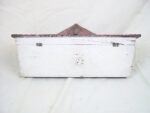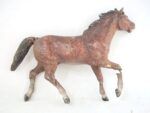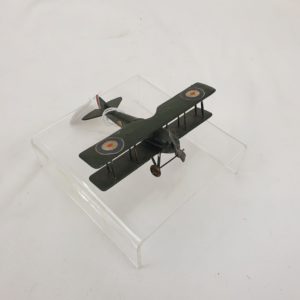A very rare farm yard set by Elastolin (Model 15130 1/2 Hausetiere Range), pre-war issue, c1935.
The set is comprised of composite walls containing a large 3 room farm house building with double hinged gates, water trough, rooftop dovecot and full length rear access panel. The set also includes a farm girl with a feeding bucket (the base is marked “ELASTOLIN”) & 17 various farm animals & poultry. The set is constructed from wood with composite detailing, such as hinged doors, etc.
~ Dimensions ~
The base has a length of 25 inches (63.5cm), a width of 14 inches (35.5cm), and a height of 2.5 inches (6.25cm).
The house has a length of 18 inches (45.75cm), a width of 4.5 inches (11.5cm) and a height of 11.5 inches (29.25cm).
The animals are of various sizes.
~ Condition ~
The house, the gating and the base all appear to be in good condition, with only some minor paint wear, though the base has a split.
The animals are in varied condition, but are mostly worn with paint chipping. Some, for example the sheep, have worse condition such as a leg missing.
~ Elastolin ~
Elastolin is a trademark used by the German company O&M Hausser (O&M Haußer) for the toy soldiers and other types of figures it manufactured from composite material and later from plastic.
Elastolin composition figures are made from sawdust, a glue such as casein, and clay (kaolin) molded on a wire armature and hand painted at the factory. The technique was developed by the brothers Otto and Max Hausser in 1912. Some collectors use the term Elastolin to refer to composite figures made by other companies, such as Lineol, as well as those made by Hausser, but this is akin to using the term “Ford” as a generic term for motor vehicles made by companies other than Ford. Hausser figures almost always have an oval base, and the name “Elastolin” is found on the underside of the base of almost all Elastolin figures (Note that the “personality” figures of General Ludendorff and Adolf Hitler seen in the photo have rectangular bases and are Lineol brand figures).
Hausser stopped manufacturing figures from composite materials in 1969. Production of plastic figures continued through 1982. The company filed for bankruptcy in June 1983 and ceased production by the end of the year.




















